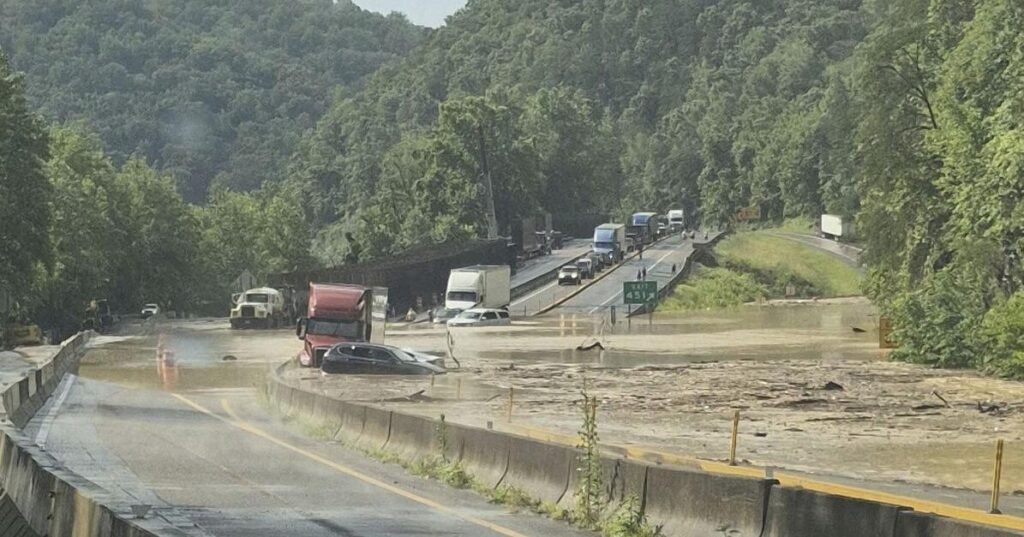I-40 Reopens Through Great Smoky Mountains After Flooding and Rock Slide
The rhythmic hum of traffic has returned to a critical section of Interstate 40 that winds through the majestic Great Smoky Mountains. After an intense period of closure due to flooding and a treacherous rock slide, this vital east-west corridor is finally welcoming travelers once again.
As someone who’s wandered these misty peaks for years, documenting their changing moods and seasons, I’ve witnessed firsthand how quickly Mother Nature can transform these ancient mountains from serene to severe.
What Happened on I-40 in the Smokies?
Recent heavy rainfall – not uncommon in what locals affectionately call “the Smokies” – triggered a significant rock slide along with flooding that completely blocked this narrow mountain passage. The closure created major disruptions for both commercial traffic and vacationers, as I-40 serves as one of the primary cross-country highways connecting the eastern and western United States.
Maintenance crews worked tirelessly against the clock and elements to clear massive boulders, debris, and water from the roadway. Their dedication has paid off, with traffic now flowing freely through this spectacular mountain corridor.

Why This Stretch of I-40 Is Particularly Vulnerable
I’ve traveled this stretch of I-40 countless times, and it never fails to impress with its engineering marvel and natural beauty. However, this section of highway presents unique challenges:
- The narrow corridor squeezes between steep mountain slopes and the Pigeon River
- Rock faces tower above the roadway, constantly weathering and occasionally giving way
- The area receives some of the highest rainfall totals in the eastern United States
- The region’s geology features layers of rock that can become unstable
This combination creates perfect conditions for occasional slides and flooding, though the Tennessee and North Carolina Departments of Transportation maintain vigilant monitoring systems.
Impact on Local Communities and Travelers
When I-40 closes through the Smokies, the effects ripple far beyond inconvenienced travelers. Local communities depend on this artery for everything from daily commerce to emergency services.
During this closure, drivers faced lengthy detours – some adding hours to their journeys. Local businesses that depend on pass-through traffic saw sharp declines in customers. Meanwhile, trucking companies scrambled to reroute shipments, adding costs that eventually impact consumers.
| Detour Route | Additional Distance | Extra Travel Time |
|---|---|---|
| Via I-26 and I-81 | ~85 miles | 1.5-2 hours |
| Via US-25/70 | ~45 miles | 1-1.5 hours |
What Travelers Should Know Now
If you’re planning to travel through the Great Smoky Mountains on I-40, here’s what you need to know:
- All lanes are now open in both directions
- Some residual cleanup work may be ongoing in shoulder areas
- Expect potential delays as traffic patterns normalize
- Watch for possible temporary lane closures as final repairs continue
I’d recommend checking the Tennessee and North Carolina Department of Transportation websites before traveling through this area in the coming days, as conditions can change rapidly in mountain terrain.
The Silver Lining: The Smokies’ Remarkable Resilience
While road closures create headaches, they also remind us of something special about these mountains I’ve come to love so deeply. The same geological and weather forces that occasionally disrupt our travel plans are precisely what shaped the stunning landscapes that draw millions of visitors annually.
The Great Smoky Mountains National Park – just a stone’s throw from this section of I-40 – remains the most visited national park in America for good reason. Its ancient peaks, diverse ecosystems, and rich cultural heritage continue to captivate despite (and sometimes because of) their wild nature.
Looking Forward: Infrastructure Improvements
This latest closure has renewed discussions about infrastructure improvements along this critical corridor. Engineers continue to develop innovative solutions to mitigate future slides and flooding, balancing the need for reliable transportation with the practical challenges of building in such dramatic terrain.
Having watched these mountains through all seasons and situations, I’m continually impressed by how humans and nature find ways to coexist in this remarkable place – even when that relationship occasionally involves detours and delays.
Plan Your Next Smoky Mountain Adventure
With I-40 reopened, now might be the perfect time to plan your own journey through this spectacular region. Whether you’re just passing through or making the Smokies your destination, the mountains are showing their summer splendor with lush forests, flowing waterfalls, and that characteristic blue haze that gives them their name.
Safe travels as you make your way through one of America’s most beautiful and occasionally challenging mountain passages.
For the latest updates on road conditions in the Great Smoky Mountains region, visit the Tennessee Department of Transportation website.

